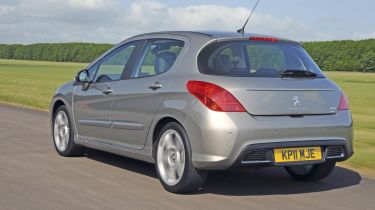Peugeot 308 1.6 e-HDi
New 308's fresh styling and engine line-up make hatch a tempting proposition
Has Peugeot done enough to put the 308 at the top of the family car sector? New looks and engines suggest the brand has done plenty of work, but on the outside at least, the changes haven’t gone far enough.
The styling revisions are welcome, yet there’s still room for improvement. It works best from the front, where the redesigned grille is set off by sharply styled headlights and LED daytime running lamps. It has a wider and sportier appearance than its predecessor.
Video: watch CarBuyer's video review of the Peugeot 308
[[{"type":"media","view_mode":"content_narrow","fid":"68664","attributes":{"alt":"","class":"media-image"}}]]
At the rear, the updates are less successful, particularly the ill-conceived flash of chrome across the tailgate. Changes to the cabin are less dramatic. The 308 is still well laid out, spacious and neatly detailed. There are some decent-quality plastics to be found, and the metal-effect trim is the most convincing finish here.
However, the electric driver’s seat didn’t adjust low enough for our liking, and the awkward pedal layout makes for an uncomfortable driving position. This situation isn’t helped by the Peugeot’s oversized leather steering wheel.
To compensate for these shortcomings, the cabin does benefit from a generous spec, with half-leather upholstery, dual-zone climate control, a USB connection, cruise control and a full-length panoramic glass roof all standard on Allure models.
The roof improves the feeling of space inside, but it also affects the driving experience. You can sense the whole bodyshell flex over big undulations, as the Peugeot creaks and rattles its way along rough roads and around bends. The 112bhp 1.6-litre HDi engine is the 308’s best feature and the most refined here.
In raw performance terms, it trailed its rivals against the clock, but what stands out is its smoothness. Stopping power was excellent, too. The 308 took 46.3 metres to get from 70-0mph – beating its nearest rival by 3.1 metres.
Our test car’s wide 18-inch rims helped here, but they also contribute to the harsh ride from the firm suspension. This is especially noticeable when you hit unsettling mid-corner bumps. The electric power-steering set-up doesn’t help, as it provides little in the way of feedback and has an artificial feel, especially at low speeds.
Instead, the stop-start system is the biggest revelation. Thanks to the clever use of super capacitors, which jump-start the battery, and an alternator that is 70 per cent more powerful than previous versions, the car fires up almost instantly – and with little vibration. The engine is restarted faster and more smoothly than the rival VW and Ford systems.
Unusually, the clever kit also operates at temperatures as low as -5 degrees Celsius, and works at speeds below 12mph. This encourages coasting in town, but since the electric power-steering and brakes remain fully functional, it can bring real efficiency benefits.
Or can it? In the final analysis, we were disappointed by the Peugeot’s test economy of only 38.4mpg, which trailed the Focus and class-leading Golf.
This should have come as no surprise, though – in high-spec Allure trim, the 1.6 e-HDi is the most polluting model of our quartet.
Details
Chart position: 4
WHY: Maker is aiming to take the family hatch sector by storm with its revised 308. A neat facelift, eco-friendly new engines and weight reduction all feature.







